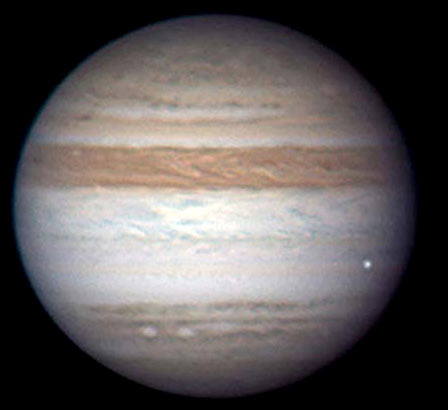Amateur astronomers track asteroids as they impact Jupiter
Amateur astronomers armed with video cameras may provide much-needed data on the number of large asteroids slamming into planets like Jupiter, and help improve estimates of the danger that near-Earth asteroids pose for our planet.
In a paper accepted for publication in Astrophysical Journal Letters (ApJ), astronomers report follow-up observations of a June 3, 2010, asteroid impact on Jupiter that first was noticed by two amateur astronomers.

"These amateur astronomers – Christopher Go in the Philippines and Anthony Wesley in Australia – saw a flash of light lasting about two seconds, which is the first time such a small object has been observed impacting Jupiter," said co-author Imke de Pater, professor and chair of the Department of Astronomy at the University of California, Berkeley. "I bet that if we looked at other data amateurs have, we would see many more events like that."
The team of professional astronomers subsequently observed the impact region at various wavelengths, from the ultraviolet through the visible and in the near- and mid-infrared, using the Hubble Space Telescope; the 10-meter Keck and 3-meter NASA IRTF (Infrared Telescope Facility) in Hawaii; the 8-meter Gemini North and South telescopes in Hawaii and Chile, respectively; and the 8-meter Very Large Telescope in Chile.
Since the ApJ paper was submitted, two amateur astronomers in Japan – Masayaki Tachikawa and Aoki Kazuo – observed on Aug. 20 another asteroid collision with Jupiter.
De Pater said that both of these bolides, or fireball meteors, "were 10-meter objects, leaving trails for less than two seconds," and that the impacts were too small and too brief to be observed by professional astronomers except by chance. These amateurs, however, were able to record for long periods of time using color video cameras, which are ideal for capturing transient events such as impacts.
De Pater and some of the same co-authors have had a paper accepted by the journal Icarus that analyzes another Jupiter impact discovered by Wesley in Australia on July 19, 2009. That impact, de Pater said, involved an asteroid entering Jupiter’s atmosphere along a shallow angle and exploding just below Jupiter's cloud layers.
The most famous impact discovered by an amateur was Comet Shoemaker-Levy 9, which crashed into Jupiter in 1994, creating a scar visible for weeks.
According to the authors of the ApJ paper, the June 3 asteroid was 8-13 meters in diameter and packed a punch equivalent to a 250- to 1,000-kiloton nuclear bomb — smaller than the violent airburst that decimated trees for 40 kilometers around Tunguska in central Siberia 100 years ago, but similar in its effects.
These initial observations, if supplemented by future observations of asteroid impacts on Jupiter by other amateur astronomers, could help scientists understand the behavior of meteoroids of various dimensions and compositions entering an atmosphere at varying angles and speeds, said co-author Mark Boslough of Sandia National Laboratories.
“These amateur observations are very important,” he said. “To me, the primary significance is the demonstration that relatively small bolides on Jupiter can directly be observed from Earth, that their energy can be quantified and that such impacts are frequent enough to observe.”
A continuous amateur observation campaign could provide data to determine the impact intensity and size of asteroids in the vicinity of Jupiter.
Link to the paper published in the Astrophysical Journal Letters.
